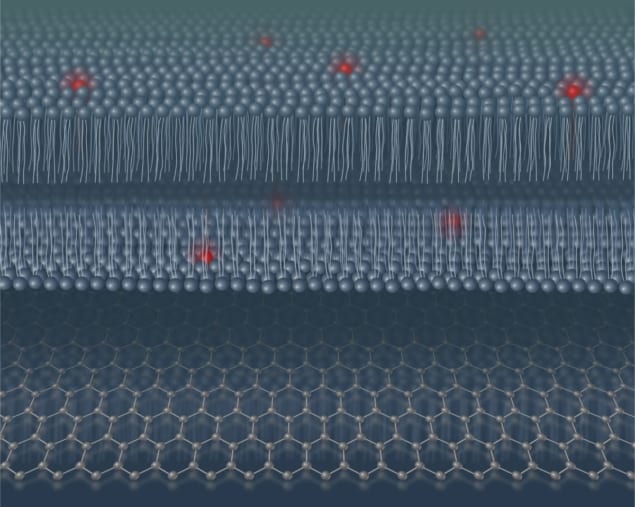
Sub-nanometre resolution in 3D position measurements of light-emitting molecules has been achieved by physicists in Germany. Jörg Enderlein and colleagues at the University of Göttingen achieved the result by replacing metal films used in previous super-resolution techniques with single layers of graphene. Their innovation could allow researchers in a wide variety of fields to measure molecular positions to unprecedented degrees of accuracy.
Recently, the technique of single-molecule localization super-resolution microscopy (SMLM) has become an incredibly useful tool for researchers in fields ranging from fundamental physics to medical research. By analysing images of single light-emitting molecules, researchers can pinpoint the positions of their centres to within single atomic widths. However, SMLM faces one significant shortcoming: it can only locate molecules in 2D, giving no information about their positions along the out-of-plane axis.
This problem can be partially overcome through the technique of metal-induced energy transfer (MIET), which introduces a thin metal film to the setup. The idea is that the apparatus picks up changes in the molecule’s fluorescence that are caused by the molecule coupling to collective excitations of surface plasmons in the film. Since this light emission varies with distance from the film, researchers can use MIET to calculate the molecule’s distance relative to the film surface, allowing them to locate it along the third axis. Yet with current versions of the technique, the accuracy of axial localization (along the vertical axis) measurements is of the order of 2-3 nm.
Atomic-scale resolution
Enderlein’s team aimed to improve this accuracy by replacing the metal film with graphene, which is a film of carbon just one atom thick. This setup also results in distance-dependent fluorescence through coupling between the graphene and the emitter. This time, however, the spatial resolution in the out-of-plane direction is nearly 10 times better than in previous studies that used the metal film. For the first time, this setup, called graphene-MIET (gMIET), allowed for measurements of molecular positions to resolutions of one angstrom – 10–10 m or 0.1 nm, which is roughly the “size” of an atom in a solid or molecule.

Super resolution microscopy gets a dose of deep learning
The researchers demonstrated this super-resolution by measuring the thicknesses of single lipid bilayers – the two, opposite facing, 2D films of tadpole-shaped molecules which form cell membranes. By localizing fluorescent dyes attached to the heads of the molecules in each bilayer, relative to a graphene film, Enderlein and colleagues estimated a membrane thickness of around 5 nm. This result is remarkably consistent with the known value. With further improvements, the team believes that gMIET could be used to resolve distances between individual molecules; more complex groups of molecules; and small cellular structures, with sub-nanometre accuracy.
The technique is described in Nature Photonics.



